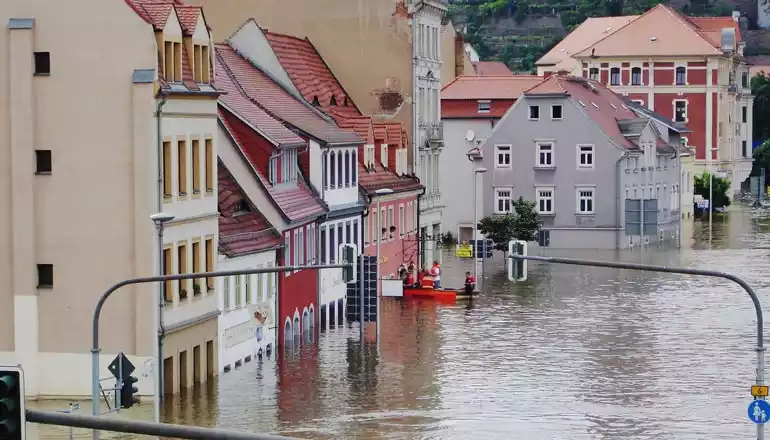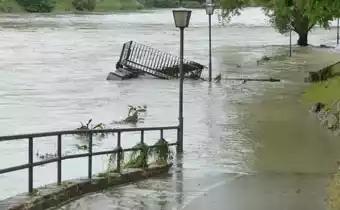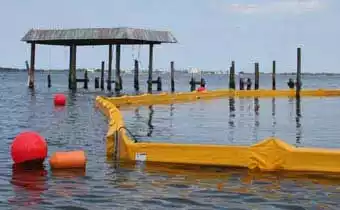August 2, 2019
Stormwater Pollution Prevention Plan for Cities

As flood waters rise around the country, developing a stormwater pollution prevention plan, protecting ecosystems and waterways, and maintaining compliance becomes even more important for cities small or large.
When developing your stormwater pollution prevention plan and flood plans for your city, it's important to ask yourself several questions.
- Is your city prepared for a flood emergency?
- How deep will the waters be when they rise?
- What areas will be at the highest risk of destruction?
Cities are often looking for solutions after storm waters rise instead of before they strike.
Hurricane Harvey caused around $125 billion dollars in damages in the state of Texas in 2017 and killed 68 people. Since then Texas has set aside money for more natural and manmade approaches to flood control. The Rainy Day Fund, as it's called, will attempt to mitigate flooding in the most vulnerable parts of the state.
Is your city prepared for a flood emergency?
Texas has learned from the past and now is making a plan for future storms.
Being proactive and making a plan to deal with flooding before the waters rise, to mitigate stormwater runoff, and to prevent waterway contamination, will ensure your city's water supply and your citizens are safe. More so, it will ensure you keep in compliance with best management practices (BMPs) for stormwater pollution.
Make a Plan to Control Stormwater Runoff and Flooding
 With its new Rainy Day Fund, municipalities across Texas will have access to grants and loans for different flood-prevention projects and plans. Other states like Illinois and Minnesota have their own flood prevention initiatives that include mapping out flood-prone areas or giving out grants for community-lead projects.
With its new Rainy Day Fund, municipalities across Texas will have access to grants and loans for different flood-prevention projects and plans. Other states like Illinois and Minnesota have their own flood prevention initiatives that include mapping out flood-prone areas or giving out grants for community-lead projects.
The green initiatives Texas is implementing include using sand dunes, rather than levees and gates, to keep flood waters at bay. Pocket prairies in a vacant lot, front yard, or parking lots, are also a strategy the state might be implementing. When flood prevention methods are needed to be quickly set up, barrier walls are a viable stormwater BMP.
Flood barrier walls are a viable and accessible option for controlling flood waters as they come. Useful in flash flooding, these flood barriers offer three different models and shapes: U-panel, 4-panel, and circular design.
Managing floodwaters has far reaching effects beyond stopping floods as they happen. Preventing stormwater pollution before the rains come will ensure a safe and healthy community. Investing in tools to mitigate stormwater runoff, control debris dispersion, and hold contaminants in water will ensure your municipality is in compliance and your community is on the right path toward clean waterways.
Protecting Storm Drains During Floods
 As stormwater rises, it carries with it contaminants and debris.
As stormwater rises, it carries with it contaminants and debris.
This water flows toward storm drains, either clogging them or simply putting contaminants into your city's drinking water.
An economical answer to stormwater BMPs can be found in an over grate stormwater filter.
Six basic models of stormwater over grate filter exist:
- High Visibility with Overflow Window
- Low Visibility with Overflow Window
- High Visibility without Overflow Window
- Low Visibility without Overflow Window
- High Visibility with Round Shape
- Low Visibility with Round Shape
The over grate stormwater filter can be installed by one person and offers a low profile design that won't inhibit people walking or cars driving in the street. Keeping out debris and sediment, as well as some insects, the over grate filter is a proven BMP for a stormwater pollution prevention plan.
An under grate filter to catch debris that falls through the drain before it enters waterways is another proven stormwater bmp. This type of stormwater pollution prevention acts as a basin for heavy debris and also features overflow ports to prevent heavy flooding. Stormwater BMPs like this keep pollutants from entering the watershed.
Controlling Debris and Sediment in the Water
 Controlling debris that has already entered the waterways is will be a valuable stormwater BMP. When containing trash or debris in a body of water, a floating boom can help to corral the contaminants for easier clean up.
Controlling debris that has already entered the waterways is will be a valuable stormwater BMP. When containing trash or debris in a body of water, a floating boom can help to corral the contaminants for easier clean up.
Confining this debris before attempting to clean up the water will put your city at risk of contaminating the environment even further. Part of your stormwater pollution prevention plan should include the containment, deflection, and exclusion or trash and debris in municipality waterways.
When containing contaminants on the surface of the water isn't enough protection, and containing silt and sediment in the water itself is necessary, then a turbidity curtain for silt containment is what your municipality needs.
Like with the floating boom, the type of turbidity curtain you'll use in your waterways will depend on how much debris or silt you need to contain, the water conditions, wind conditions, and duration of your project. Keeping in compliance with DOT regulations might require you to meet specific guidelines in your BMP stormwater plan.
Perhaps you need to remove sediment or sludge from a pond or lake. One of the most commonly used solutions for this type of stormwater pollution prevention is dewatering bags. By pumping water into the bag, you retain the sediment and the water stays in the same location. Dewatering bags are helpful for small scale efforts, but for large municipalities, dewatering tubes offer larger containment options with stronger material.
Whether you're looking for large scale stormwater BMPs or smaller scale solutions, removing sediment and sludge from bodies of water through dewatering solutions will keep your city in compliance and extend the viability of your waterways.
Implementing a Stormwater Pollution Prevention Plan
 Whether you're looking for manmade flood and stormwater BMPs or more natural stormwater pollution prevention solutions to reduce the effects of stormwater runoff, having a plan that fits your municipality is the first step in the right direction.
Whether you're looking for manmade flood and stormwater BMPs or more natural stormwater pollution prevention solutions to reduce the effects of stormwater runoff, having a plan that fits your municipality is the first step in the right direction.
Remember that containing sediment and water is important in three stages:
- As it falls and floods
- Before it reaches storm drains
- Once it's in the water
Each stage will occur, but it's how you approach them that will save your city from the far reaching effects of stormwater runoff left unchecked.
At Clarion Municipal, our stormwater BMPs are made to meet your requirements, keeping you in compliance with regulations and helping you accomplish your clean up efforts.
Do you have questions about how you can make a stormwater pollution prevention plan to stop the ruin of your waterways from sediment, trash, or debris? We can help. Contact us today or call us at 863-261-8388.

